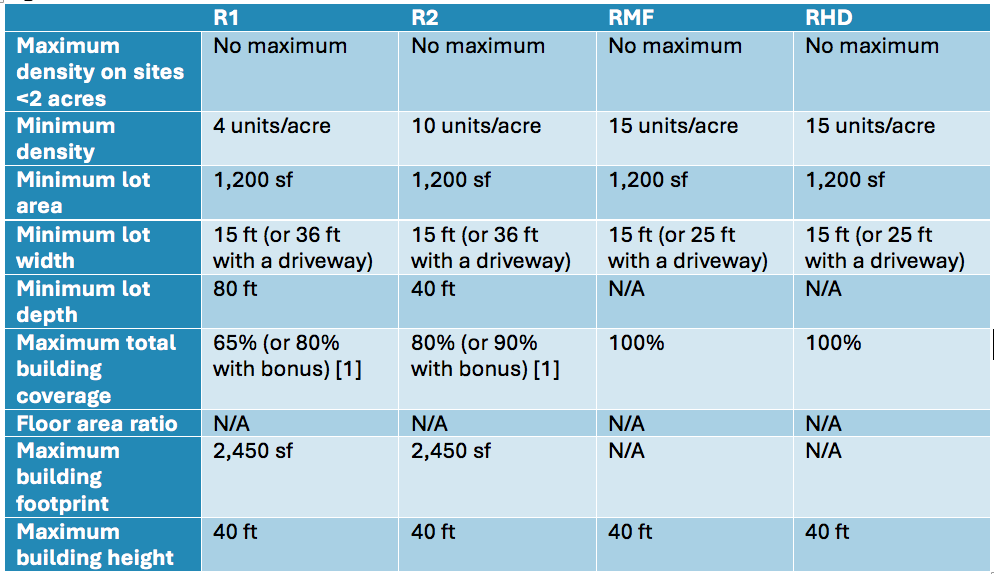Last week, Spokane finalized its year-long effort to legalize more housing choices across the city. Their new code sets a statewide standard, and it should be emulated in cities large and small — from Seattle and Bothell to Yakima and Vancouver.
Recall that under the zoning package passed last year, Spokane gave itself a year to develop a new permanent development code for fourplexes and other middle housing types.
Perhaps predictably at this point, the city one-upped itself again, going further than any other city in Washington, and maybe even further than any other city in the country in legalizing new housing. When the final rules shook out, the city didn’t just legalize fourplexes across the city — it legalized plexes, townhomes, cottage housing, and small apartment buildings of all different shapes and sizes. Some provisions could also make backyard cottages, also known as detached accessory dwelling units (DADUs), easier to build.
In fact, the new rules allow any number of units they can reasonably fit on a site of less than two acres (though sixplexes will generally be the most likely given lot coverage and height limits). Even better, in lieu of using floor area ratio (FAR) or some other metric to govern a development’s scale, the new code uses a relatively straightforward set of dimensional standards:
- No maximum density on sites of less than two acres.
- 1,200 square foot minimum lot size.
- 65% lot coverage maximum.
- 40-foot height limit.
- 10-foot front setback, three-foot side setback.
- DADUs get reduced setbacks.
See Figure 1 and Figure 2 below for specifics on the adopted dimensional standards and setback requirements. These charts are simplified from official City versions for readability.
Figure 1. Dimensional Standards

A bonus applies when a project is:
- Located within a half-mile of a major transit stop.
- Located within a half-mile of a Centers and Corridors zone.
- Owned by a religious organization and intended for affordable housing.
- Affordable (receiving 20-year Multi-Family Tax Exemption or MFTE or at least 25% of units are affordable to people earning 80% or less of area median income).
- Affordable (receiving 20-year MFTE or at least 25% of units are affordable to people earning 80% or less of area median income).
Figure 2. Minimum Setbacks

Near transit and mixed-use zones, on properties owned by religious institutions, or specifically for affordable housing, developers can boost the lot coverage of their projects to 80% even in R1 zones to unlock additional development capacity. (Some minimum outdoor space standards still apply.)
In terms of parking, the new permanent code technically requires one stall per unit, plus one stall per accessory dwelling unit (ADU) and one additional stall beyond three bedrooms. But these parking standards are waived entirely for middle housing located within a half-mile of a transit stop, which covers most of the city. And under Spokane’s existing code, up to 25% of required parking may also be swapped for bicycle parking.
Particular attention in the new code was given to ADUs, which have outsized potential in Spokane given the city’s historic grid and extensive alleyway system. Off of alleys, ADUs now get zero-foot setbacks, and they can feature a 1,100-square-foot dedicated maximum building footprint and a 25-foot maximum building height (Figure 3). During commentary on the zoning package, Councilmember Michael Cathcart expressed hope that these allowances would result in more laneway homes across the city.
Figure 3. Accessory Dwelling Units (ADUs)

In every case, Spokane’s elected officials, department leaders, and planners tried to strip away unnecessary layers of regulation and ensure that the new code actually allows middle housing to be built, and quickly. Local planners and leaders, like Planning Director Spencer Gardner and Senior Planner Kevin Freibott, defied stereotypes of their profession by advocating for specific solutions that in their professional judgment would help boost housing production, rather than deferring (or abdicating) to easily-manipulated, often-delayed process-oriented community engagement to determine outcomes.
During its legislative session on November 20, Spokane’s City Council heard from almost a dozen community members from diverse backgrounds — from the director of an employment equity organization to Michelle Pappas of Futurewise, from homeowners to homeless advocates, and from low-income housing developers to the market-rate and ardently conservative Spokane Homebuilders Association. In sharp contrast to the oft-contentious comment periods on housing topics at Puget Sound-area councils, feedback was uniformly positive.
Even a brief moment of disagreement — over whether four-story buildings should be allowed if they can still meet a 40-foot height limit — led to levity from the dais as outgoing Council President Lori Kinnear, typically a voice of moderation on these missing middle ordinance, joked with Councilmember Zack Zappone. Though she was the sole member voting no on an amendment to allow this edge case, she still joined the Council majority to adopt the package on a unanimous 6-0 vote.
All indications are that Spokane’s missing-middle reform will make a real difference. Seattle developer and Planning Commissioner Matt Hutchins already has a sixplex in permitting, as do dozens of others. As of July 1, the latest the City made data available, more than 455 missing middle housing units were in permitting under the slightly more restrictive interim rules, and 76 had already been approved. (And despite concerns about displacement or concentration, they’re remarkably well-distributed across the city.)
I just filed this for permit in Spokane. This sixplex is a personal development project for me, my first. Big leap, but proof of concept for infill dev that is n’hood friendly, affordable, and high quality living, something we hope to export to Seattle once HB1110 is in force. pic.twitter.com/21hVItW9BX
— Matt Hutchins (@HutchinsMatt) September 21, 2023
Those numbers are now sure to only grow from here as the city further cements itself as a nationwide housing leader.
Now, elected officials, planners, affordable housing advocates, and developers across Washington should do more to adopt Spokane’s aggressive pro-housing approach.
Housing advocates and developers can start by offering feedback on the Department of Commerce’s proposed model code to apply the state’s freshly-passed missing middle housing law (House Bill 1110). So far, that state model code lacks the vision or foresight of Spokane’s code in legalizing sixplexes citywide in a way that ensures they can actually be built. Commerce is hoping to receive feedback by Wednesday, December 6 so it can publish final versions of the model ordinances by January 23. In lieu of delay, a simple solution would be to lift Spokane’s reasonable dimensional standards whole-cloth.
Planners across the state can take a lesson from Spokane by simply using their professional expertise to make strong recommendations to elected officials and leadership. The planning profession, particularly in the Puget Sound region, tends to prioritize process over outcomes. It’s understandable; the public is hard to satisfy, and decisions are hard! But Spokane shows that you can choose outcomes first. Spokane decided to allow missing middle housing first, and then determined how it would do so, giving itself a hard one-year deadline.
Leaders in the state legislature should look at Spokane and consider how much longer they are willing to let cities like Seattle, Everett, and Yakima shirk their responsibility to plan for new middle housing in their communities. Yes, House Bill 1110 gives a grace period for implementation, and yes, interest rates and high construction costs are hindering development right now. But that won’t be the case forever, and we’ve been chronically underbuilding for decades. How much longer are we willing to wait? And do we really trust cities to legalize middle housing in a way that allows it to actually be built? State legislators should be looking to California’s Housing and Community Development Department and its Housing Accountability Act for inspiration. And perhaps it’s finally time for a builder’s remedy when cities objectively fail to meet their communities’ needs.
And finally, local elected officials across the country should consider that Spokane offers an alternative path to one of rancor and indecision over new housing. If you set up the process properly, if you can be comfortable with strange bedfellows, if you can bring on (or have!) a rockstar planning team, and if you have an active base of community advocates, there’s nothing stopping you from bringing the community together for housing justice. And though it will still be a challenge and a lot of work, the sheer joy that comes from doing so will be worth it.
Anthony Gill is an economic development professional and writer at Spokane Rising, an urbanist blog focused on ways to make Spokane a better place to live.


